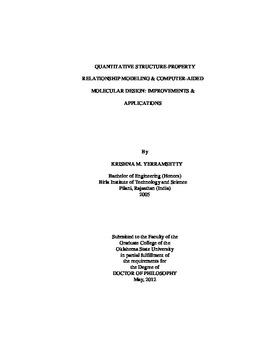| dc.contributor.advisor | Gasem, Khaled A. M. | |
| dc.contributor.author | Yerramsetty, Krishna M. | |
| dc.date.accessioned | 2015-01-05T15:54:35Z | |
| dc.date.available | 2015-01-05T15:54:35Z | |
| dc.date.issued | 2012-05 | |
| dc.identifier.uri | https://hdl.handle.net/11244/14045 | |
| dc.description.abstract | Scope and Method of Study: The objective of this work was to develop an integrated capability to design molecules with desired properties. An automated robust genetic algorithm (GA) module has been developed to facilitate the rapid design of new molecules. The generated molecules were scored for the relevant thermophysical properties using non-linear quantitative structure-property relationship (QSPR) models. The descriptor reduction and model development for the QSPR models were implemented using evolutionary algorithms (EA) and artificial neural networks (ANNs). QSPR models for octanol-water partition coefficients (Kow), melting points (MP), normal boiling points (NBP), Gibbs energy of formation, universal quasi-chemical (UNIQUAC) model parameters, and infinite-dilution activity coefficients of cyclohexane and benzene in various organic solvents were developed in this work. To validate the current design methodology, new chemical penetration enhancers (CPEs) for transdermal insulin delivery and new solvents for extractive distillation of the cyclohexane + benzene system were designed. | |
| dc.description.abstract | Findings and Conclusions: A robust general framework for designing new molecules and an improved framework for building accurate models for thermophysical properties have been developed. In general, the use of non-linear QSPR models developed in this work provided predictions better than or as good as existing literature models. In particular, the current models for NBP, Gibbs energy of formation, UNIQUAC model parameters, and infinite-dilution activity coefficients have lower errors on external test sets than the literature models. The current models for MP and Kow are comparable with the best models in the literature. The GA-based design framework implemented in this work successfully identified new CPEs for transdermal delivery of insulin, with permeability values comparable to the best CPEs in the literature. Also, new solvents for extractive distillation of cyclohexane/benzene with selectivities two to four times that of the existing solvents were identified. These two case studies validate the ability of the current design framework to identify new molecules with desired target properties. | |
| dc.format | application/pdf | |
| dc.language | en_US | |
| dc.rights | Copyright is held by the author who has granted the Oklahoma State University Library the non-exclusive right to share this material in its institutional repository. Contact Digital Library Services at lib-dls@okstate.edu or 405-744-9161 for the permission policy on the use, reproduction or distribution of this material. | |
| dc.title | Quantitative structure-property relationship modeling & computer-aided molecular design: Improvements & applications | |
| dc.contributor.committeeMember | Robinson, Robert L., Jr. | |
| dc.contributor.committeeMember | Ramsey, Josh D. | |
| dc.contributor.committeeMember | Hagan, Martin | |
| osu.filename | Yerramsetty_okstate_0664D_11932.pdf | |
| osu.accesstype | Open Access | |
| dc.type.genre | Dissertation | |
| dc.type.material | Text | |
| thesis.degree.discipline | Chemical Engineering | |
| thesis.degree.grantor | Oklahoma State University | |
